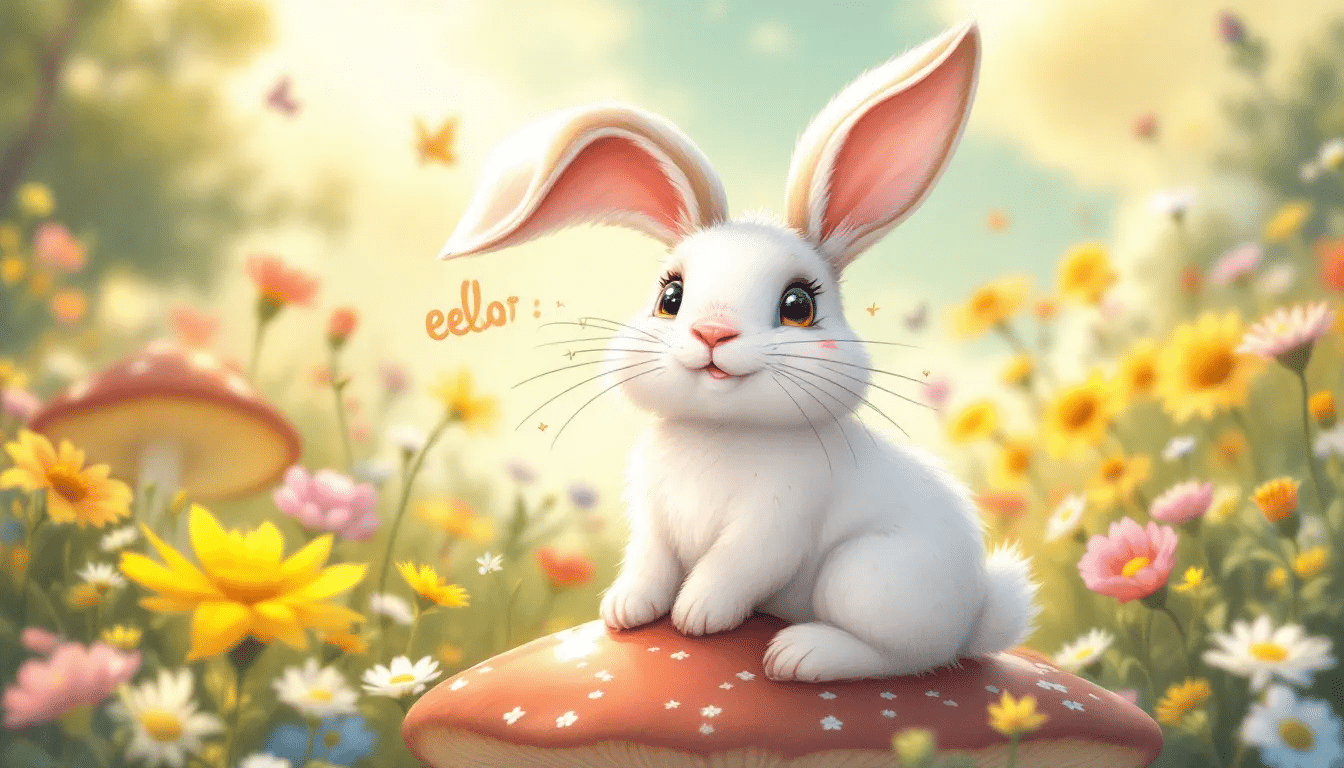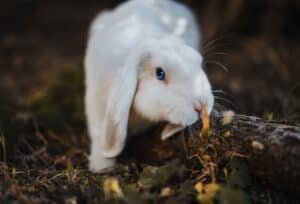Rabbits are generally quiet animals, but they do make a variety of sounds to communicate. So, what does the rabbit say? From clucking and honking to growling and screaming, each noise has a specific meaning. Rabbits also communicate through various actions, such as binkying, nose bonking, flopping, licking, and nipping. Understanding these sounds and actions can help improve your relationship with your bunny and ensure their well-being. In this article, we’ll explore the different vocalizations your rabbit might make and what they signify.
Key Takeaways
- Rabbits have a diverse range of vocalizations, like clucking, honking, and growling, that communicate their emotions and needs.
- Understanding your rabbit’s sounds, such as clucking for contentment or screaming for distress, is crucial for their well-being.
- Observing your rabbit’s body language alongside their sounds helps you interpret their feelings more effectively.
Rabbit Sounds: An Overview

Rabbits, though often perceived as quiet creatures, have a surprisingly rich vocal repertoire. These rabbit noises include muttering, squealing, clucking, and chugging, each serving a unique communicative function. Despite their usually silent demeanor, many rabbits employ a variety of sounds to express their emotions and needs. This is how a rabbit makes its feelings known.
Each rabbit has its own set of vocalizations, reflecting their individual personality. This individuality means that while one bunny might cluck to show happiness, another might honk. Understanding your specific rabbit’s sounds is key to better rabbit care and recognizing their emotional states.
Listening to these sounds allows owners to better understand and meet their pet’s needs, strengthening the human- rabbit bond. Whether it’s a sign of anger or a plea for attention, each sound is a clue to unlocking the complex emotional life of your bunny. Listen carefully to these cues.
Clucking: A Sign of Contentment
One of the most delightful rabbit noises is clucking, a quiet sound that signifies a rabbit’s contentment. This gentle, hiccup-like noise often occurs when rabbits are particularly pleased, such as during feeding times or when they are resting comfortably. Both male and female rabbits can make this sound, indicating their emotional comfort and satisfaction.
Clucking is akin to a cat’s purr in its association with happiness and relaxation. When you hear this sound, it’s a clear sign that your rabbit feels safe and content in their environment. Encouraging these moments of contentment can significantly improve your rabbit’s quality of life.
Honking: Excitement and Anticipation
Honking is another fascinating sound in the rabbit vocal repertoire, typically associated with excitement and anticipation. This sound often emerges when rabbits are eagerly awaiting food or attention. Imagine your bunny getting thrilled at the sight of a treat—this is when you might hear a distinctive honking noise.
Honking clearly indicates happiness and excitement. During play or interaction, this sound shows that your rabbit is feeling positive emotions. It’s a joyful noise that any rabbit owner will come to recognize and cherish.
Purring vs. Teeth Grinding
A rabbit’s purring, much like that of a cat’s purr, is a sign of contentment and relaxation. However, unlike the feline version, this purring is produced by gentle teeth grinding. You can often feel the vibrations or see your rabbit’s whiskers twitching when they are purring. This subtle sound is a positive indicator that your rabbit is happy and relaxed.
On the other hand, loud and sharply teeth grinding is a stark contrast and a sign of significant pain or discomfort. Distinguishing between these types of teeth grinding is key to maintaining your rabbit’s well-being. Loud grinding should prompt an immediate consultation with a vet to address any potential health issues.
Growling, Hissing, and Grunting: Signs of Anger and Threat

When rabbits feel threatened or angry, they can produce a range of aggressive sounds, such as growling, hissing, and grunting. These noises are their way of saying, “Stay away!” Growling, a short, low-pitched vibration or snort, often accompanies lunging or swatting actions. It’s a clear indication that your rabbit is feeling aggressive and wants to be left alone.
Hissing, another aggressive sound, serves to scare off potential threats. Grunting, meanwhile, is typically a warning that a rabbit does not want to be picked up or disturbed. Understanding these sounds can help owners avoid provoking further anger and know when to give their rabbits the space they need.
Respecting your rabbit’s boundaries when they shows aggressive behavior like growling or hissing can prevent escalation. Giving them space is essential for their comfort and safety. As prey animals, rabbits instinctively try not to draw attention to themselves, so aggressive sounds are a clear sign that they feel threatened or uncomfortable.
Whimpering and Whining: Expressions of Fear
Whimpering and whining are not common rabbit noises but are significant indicators of fear and distress when they do occur. These sounds are soft and subtle, often accompanied by a hunched posture or other signs of discomfort. If your rabbit is making these noises, it’s a clear sign that they are scared or in pain.
A quiet, safe environment is essential for soothing a frightened rabbit. Ensure they have a comfortable space to retreat to and offer gentle, reassuring contact to help alleviate their fear. Understanding and responding to these sounds promptly can greatly improve your rabbit’s sense of security.
Thumping: Warning Signals
Thumping is one of the most recognizable rabbit noises and serves as a warning signal. When rabbits thump their hind feet against the ground, they are alerting others of potential danger. This sound can also indicate a rabbit’s annoyance, particularly if they are unhappy with their treatment or surroundings.
Domestic rabbits may thump when they are dissatisfied, such as when put away or denied treats. Understanding when and why your rabbit thumps can reveal their feelings and help address any concerns.
Screaming: Indication of Severe Distress

Screaming is one of the most alarming rabbit sounds, indicating severe distress or pain. This scream is similar to a child’s cry and is a clear signal that your screaming rabbits are extremely frightened or in significant pain. Some rabbits scream when they feel they are in mortal danger, such as when startled or injured.
The sound of a rabbit screaming is not something you’ll forget. It’s a distressing noise that demands immediate attention. When a rabbit screams, check for potential dangers or injuries that may have caused it. Providing immediate comfort and staying close to your rabbit can help soothe them. Continued signs of distress warrant a consultation with a veterinarian.
While some rabbits may never scream, many will do so at least once in their life. Being prepared to respond promptly ensures their safety and well-being.
Other Uncommon Rabbit Noises

Apart from the common rabbit sounds, there are a few uncommon noises that rabbits make. For instance, some rabbits snore while sleeping, which is generally normal. However, if accompanied by nasal discharge, a visit to a rabbit-savvy veterinarian is recommended. Another rare sound is the soft mumbling rabbits can make when they are in a deep sleep, much like humans’ sleep-talking.
Rabbits can also experience hiccups, characterized by tiny, repeated squeaks, usually after being very active. Additionally, rabbits sneeze with cute little squeaks, but excessive sneezing could indicate a respiratory infection. Frequent sneezing accompanied by a runny nose or eyes necessitates veterinary advice.
How Rabbit Body Language Complements Sounds

Understanding rabbit body language is essential for interpreting their sounds accurately. Rabbits use their ears, tail, and body posture to convey various emotions and intentions, which enhances their vocal communications. For instance, a joyful jump and twist, known as a binky, signifies high levels of happiness and excitement. Binkying is a clear expression of joy and is one of the most delightful behaviors to observe in rabbits.
When rabbits circle or nudge you, they are showing affection and eagerness for interaction, complementing their vocal signals. A rabbit that is sprawled out or flopped over demonstrates trust and comfort in their environment. Additionally, rabbits show affection by licking with their small, wet tongues, a behavior that signifies their bond with you.
Combining observations of your rabbit’s body language with their vocalizations offers a comprehensive understanding of their emotions and needs. This holistic approach is crucial for effective rabbit care and deepening the bond between you and your bunny.
Tips for Listening Carefully to Your Rabbit
To truly understand your rabbit’s sounds, it’s essential to spend time with them. This helps you learn their unique vocalizations and body language. Different sounds, such as clucking or honking, can indicate specific emotions like contentment or annoyance.
Understanding the context of your rabbit’s noises is vital. For instance, a honk might signify excitement during play, while a thump might indicate dissatisfaction. By listening carefully and observing your rabbit’s behavior, you can better meet their needs and enhance your relationship.
Summary
Understanding rabbit sounds is a journey into the heart of your bunny’s emotional world. From content clucking to distressing screams, each noise offers insight into your rabbit’s well-being. By paying close attention to these sounds and the accompanying body language, you can provide better care and deepen your bond with your rabbit.
So, take the time to listen, observe, and engage with your rabbit. In doing so, you’ll become not only a better pet owner but also a more trusted and beloved companion to your furry friend.
Frequently Asked Questions
What does it mean when my rabbit makes a clucking sound?
When your rabbit makes a clucking sound, it means they’re feeling happy and content. It’s a great sign that your furry friend is comfortable!
Why does my rabbit honk when I give them food?
Your rabbit honks because it’s excited and anticipating food or attention. It’s their way of expressing happiness and eagerness!
How can I tell if my rabbit is in pain?
If you hear your rabbit grinding its teeth loudly, that’s a clear sign it’s in pain, and you should see a vet right away. Pay attention to any changes in their behavior, too, as they can indicate discomfort.
What should I do if my rabbit screams?
If your rabbit screams, it’s a sign of severe distress or pain, so immediately check for any danger or injuries. Comfort your bunny, and don’t hesitate to call a veterinarian if needed.
Are there any uncommon rabbit noises I should be aware of?
Absolutely, rabbits can make some unusual sounds like snoring, sleep-talking, hiccups, and sneezing. Just keep an eye on excessive sneezing, as that could mean it’s time for a vet visit.



